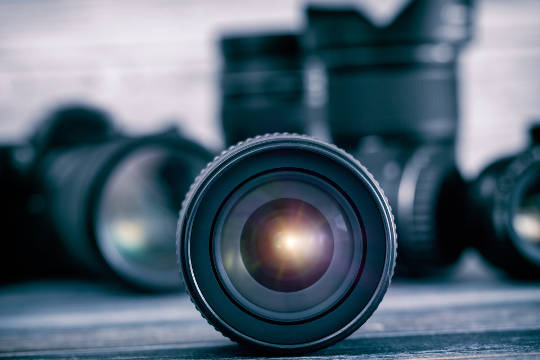TECHNOLOGY FOCUS
Thin Film Technology is pervasive in many applications, including Microelectronics, Optics, Magnetic, Hard and Corrosion Resistant Coatings, Micro-Mechanics, etc.
Progress in each of these areas depends upon the ability to selectively and controllably deposit thin films - thickness ranging from tens of Ângströms to micrometers - with specified physical properties.This, in turn, requires control - often at the atomic level - of film microstructure and microchemistry.
There are a vast number of deposition methods available and in use today. However, all methods have their specific limitations and involve compromises with respect to process specifics, substrate material limitations, expected film properties, and cost.
This makes it difficult to select the best technique for any specific application.


COURSE CONTENT
This course will provide a broad overview of modern thin film deposition methods, their possibilities and limitations.
Hands-on demonstrations and experiments in the Ångström Laboratories will help the participants to better understand the possibilities of each deposition method and stimulate informal discussions between participants and experts.
Essential fundamental aspects, as well as the technology of thin-film nucleation and growth from the vapor phase - evaporation, MBE, sputtering, and CVD are discussed in this course and highlighted with "real" examples. The participants will also learn how to test and characterize film structure and related properties after deposition.
WHO SHOULD ATTEND

Day 1
Monday - JACOBSON, EDOFF, GRANQVIST, NYBERG, HULTMAN
Thin Film Technology and Tribology
Whenever two surfaces make mechanical contact under relative motion, there is friction and wear. Coatings, made by CVD or PVD, are today extensively used on tools, for metal cutting and forming, and on machine elements, such as bearings, gears, seals and valves, to optimise their surface properties. Important phenomena and considerations in real-life applications are coating detachment, permanent surface deformation, cracking, spalling, scratching,
material pick-up, and abrasive, erosive and tribo-chemical wear. Design considerations for these coatings are discussed. In this lecture, state-of-the-art coating concepts for tools and machine elements are reviewed.
Solar Cells - Thin Films Producing Electricity
Thin film technology has been the hot topic of solar cell research for a number of years. New and less expensive thin film solar cells, with comparable efficiencies to those of crystalline silicon solar cells, have been developed. Methods deployed are sputtering, evaporation, closed space sublimation, CVD, ALCVD and electroplating. In this lecture, polycrystalline solar cells will be discussed with the emphasis on Cu(In,Ga)Se2 based devices, where the Ångström Laboratory solar cell group presently holds the "mini-module world record". In this lecture, the influence of growth parameters on material properties and hence the solar cell efficiency, will be discussed.
Optical Coatings
This lecture will cover transmittance, reflectance, absorptance and emittance of thin films of metals, semiconductors, and dielectrics. Special emphasis will be on films for energy efficiency and solar energy applications.
Vacuum in Thin Film Processing
Most lectures in "Thin Film Deposition and Applications" deal primarily with vacuum based thin film coating processes. The vacuum conditions, however, may vary significantly. Some physical vapour deposition processes have
to be carried out in ultra-high vacuum where almost no collisions between residual gas molecules and the coating material will take place. In contrast to this, there are chemical vapour deposition processes, where frequent gas collisions must take place to obtain uniform coatings of irregular substrates. This illustrates that a basic knowledge of vacuum technology and gas kinetics is required when dealing with thin film deposition processes.This lecture will provide a short review of basic gas kinetics and vacuum technology.
Thin Film Microstructures - Nucleation, Growth
This lecture begins with an introduction on substrate surface structure, reconstruction, and adsorption/desorption kinetics. Nucleation processes are treated in detail usIng insights obtained from both in-situ analysis, such as RHEED, STM, AES, and post-deposition analysis, such as TEM, XRD, and AFM.The primary modes of nucleation include: 2D step flow, layer-by-layer, and 2D multilayer; 3D; and Stranski-Krastanov. Experimental results and simulations will be used to illustrate processes controlling 3D nucleation kinetics, island coalescence, clustering, secondary nucleation, epitaxial growth, column formation, preferred orientation, residual stress formation, and microstructure evolution. The effects of low-energy ion-irradiation during deposition, as used in sputtering, arc evaporation, and plasma-CVD, will be discussed with examples.
Day 2
Tuesday - BLOM, HELMERSSON
Plasma Deposition and Plasma Etching
Both plasma deposition and plasma etching are increasingly used in thin film technology. Treated subjects are:
- Conventional DC and RF Low Density Plasmas
- High Density Plasmas
- Plasma Diagnostics
This lecture will provide a general understanding of plasmas
used in thin film deposition.
Sputter Deposition
Sputter deposited film properties depend on the parameters of the sputtering system, such as pressure and substrate bias.We will discuss the cause and effect of changes in sputtering parameters on the energetics of the sputtering and deposition processes and their relationship to film properties. The energy and distribution of species, ejected from the target, are explained. The effect of the sputtering system on material transport to the substrate and subsequent film deposition is also discussed for films of metals, alloys, and compounds. The parameters of different sputtering systems with DC, pulsed DC, and RF power supplies are discussed with respect to film properties. This lecture will cover:
- Target Effects and the Nature of Sputtered Atoms
- Magnetron, Diode, Triode, and Ion Gun Systems
- DC, Pulsed DC, and RF Systems for Targets and Substrates
- Ionized Sputtering, Especially High Power Impulse Magnetron Sputtering (HiPIMS)
PVD Experiments in the Ångström Lab
Day 3
Wednesday - JOE GREENE
Overview of the more than 5000 year History of Thin Film Science
This short lecture traces the recorded history of the thin film science from the late stone age/early bronze age through the first golden age of thin films (late 1700s through the 1800s) into the second golden age (the present time). Many of the "high-tech" advances we view as the signature of modern thin film science have their genesis in ancient to "olden" times. Thin film physics, including quantum mechanics, will be compared to the theory of atoms as building blocks of nature developed by pre-Socratic philosophers/scientists. The lecture ends with a status report on the present vitality of thin films as a coherent field of study.
Thermal Evaporation Processes for Film Growth
Thermal evaporation is used in a wide variety of film growth processing technologies with applications ranging from optical, magnetic, and microelectronic to functional coatings. In this lecture, we will discuss the thermal evaporation process, the relationship between evaporation rate and vapor pressure, flux directionality, and film thickness uniformity. Advantages and disadvantages of common and specialized evaporation sources including filaments, boats, Knudsen cells, effusion cells, and electron beam sources will be described with examples. Reactive evaporation of compounds including oxides and nitrides, as well as III-V and II-VI semiconductors, will be compared with ion plating (activated reactive deposition) for compositional control of complex materials. The use of in-situ deposition rate monitors including quartz crystal oscillators and optical spectroscopy will also be covered.
High Rate Reactive Sputter Deposition: Mechanisms and Process Control
This lecture covers the fundamental mechanisms and technology of high rate reactive sputter deposition of conducting and insulating thin films. Following a brief introduction to reactive sputtering, including discussion of basic issues, target choices, and system configurations, we examine the effects of reactive gas addition on target surface and glow discharge processes which control film growth rates. Process control strategies (e.g.: flow, partial pressure, target voltage, and multi-loop control) and their implementation are described using numerous examples. The advantages and disadvantages of these different modes of operation are examined from the point of view of controlling film properties. Emphasis is placed on developing a sufficient understanding of reactive sputter deposition to provide direction in designing new processes. The effects of energetic particle irradiation (positive and negative ions and fast neutrals) are also discussed. Present and future trends in reactive sputter deposition are addressed.
Mechanisms of Stress Evolution in Thin Films
Compressive stress in magnetron sputter deposited thin films (vs tension in evaporated films) deposited at low temperatures initially inhibited the use of sputtering in many coating applications. Further complicating the situation is that measured stresses in films deposited under nominally the same deposition conditions can vary widely. We now know that much of the disparity is due to the fact that film stress arises from a variety of different mechanisms, including differential thermal contraction, island coalescence, grain growth, competitive columnar growth, and energetic particle bombardment and that some of these mechanisms are film thickness dependent. Recently, however, a rather detailed understanding of stress evolution has emerged such that it is now possible to "tune" the stress/strain characteristics of a film during deposition, thereby spawning the new field of "strain engineering." This lecture will discuss the primary mechanisms leading to film stress in vapor deposited films, explain, for example, why evaporated films are often in tension and sputtered films in compression, and discuss strategies for controlling film stress.
Growth of Self-assembled Nanostructures
(The materials science of small things: self-assembly and self-organization in inorganic systems) The study of nanotechnology is pervasive across widespread areas including microelectronics, optics, magnetics, hard and corrosion resistant coatings, mechanics, etc. Progress in each of these fields depends upon the ability to selectively and controllably deposit nanoscale structures with specified physical properties. This, in turn, requires control, often at the atomic level, of nanostructure, nanochemistry, and cluster nano-organization.
Deceasing size scales of solid clusters can result in dramatic property changes due to both "classical" effects associated with changes in average bond coordination and, as cluster sizes become of the order of the spatial extent of electron wavefunctions, quantum mechanical effects. This lecture will start with examples including reduced melting points, higher vapor pressures, increased optical bandgaps, metal-to-semiconductor transitions, nano-catalysis, decreased magnetic hysteresis, and enhanced mechanical hardness. Essential fundamental aspects, as well as the technology, of nanostructure formation and growth from the vapor phase will be discussed and highlighted with "real" examples using insights obtained from both in-situ and post-deposition analyses.
Nanostructure case studies include:
Template, size, and coarsening effects: self-assembled Si/Si(001), Cu/Cu(001), TiN/TiN(001), TiN/TiN(111) nanoclusters and 1D Cu/Pd(011) and Pd/SnO2(101) wires
Controlled template plus strain effects: self-organized Ge wires on Si(111), Ge wires on Si(187 72 81), Au chains on Si(553), InAs metal wires on GaAs(001), insulated metal wires on Si(111)
Quantum dot engineering: formation, shape transformations, and ordering in self-organized SiGe/Si(001); InAs/GaAs(001), CdSe/ZnSe(001), PbSe/PbEuSe(111), and Ag/Pt(111) quantum dots
Nano-catalysis: Au/TiO2
3D nanostructures: (Ti,Ce)N/SiO2, TiBX/SiO2, and (-TaN / (-Ta2N/SiO2.
Day 4
Thursday - BOMAN, LARSSON
Chemical Vapour Deposition (CVD) and Atomic Layer Epitaxy (ALE)
Chemical reactions, occurring usually on the surface, are used both in CVD and ALE to deposit thin films on substrate surfaces. In CVD, a reaction mixture is introduced continuously into the reactor, while in ALE the reactants are introduced sequentially.The latter technique permits a very precise control of the film thickness since a monolayer is deposited each at a time. This lecture will treat the basics of these techniques, all the way from deposition process and reactor design to the chemistry behind the interfacial reactions yielding the films. Finally, the evolution of the microstructures and properties of the films will be discussed in connection to process parameters.
Laser Chemical Micro Machining
The lecture will introduce lasers as a tool for materials deposition and materials removal using chemistry.
- Experimental Techniques Using Lasers
- Laser Assisted Etching and Deposition
- Laser Ablation
- 3-D Growth of Microstructures
- Photolytic (Non-Thermal) Deposition
CVD Experiments in the Ångström Lab
Day 5
Friday
APPLICATIONS: PROBLEMS AND SOLUTIONS
Choose between three parallel sessions: A, B or C
A - Characterization of Thin Film Microstructures
KLAUS LEIFER
In this lecture, the principles of analytical electron microscopy will be described. Particular emphasis will be given to more recently developed analysis techniques such as SEM, EBIC, TEM, EDS, EELS, ESI, STEM, High Angle Annular STEM, and Electron Holography. Hands-on Experiments: Participants will have the opportunity to use state-of-the-art electron microscopes and specimen preparation equipment.
B - Optical Characterization of Thin Film Surfaces
ARNE ROOS
The Ångström Optics Laboratory is equipped with several types of Spectro-Photometers for optical measurements in the wavelength range from 200nm to 50 mikrometer. Transmittance and reflectance measurements can be performed both on perfectly flat surfaces and on scattering surfaces, both at near normal incidence and versus angle of incidence, by the use of polarized light. A Spectroscopic Ellipsometer is also available, covering the wavelength
range from 270 to 1700nm.
Hands-on Experiments: Various measurements will be performed according to the need and interest from the participants. The following measurements can be performed:
- Reflectance and Transmittance Measurements
- Angular Dependent Optical Properties
- Diffuse Reflectance and Transmittance
- Color Coordinates
- Spectral Integration of Solar Selective Surfaces
- Absorption in Solids and Liquids
C - Tribological Coatings
KASSMAN-RUDOLPHI, WIKLUND
This session will specialize on Tribological Coatings for industrial applications.
Hands-on Experiments will be performed in the Ångström Tribology Laboratory.
- Technical Requirements on Tribological Coatings: Cutting, forming, sliding and rolling
- Wear Resistance of Coatings: Hardness, residual stress, toughness
- Current Trends in Design, Manufacturing, and Application
- Substrate Preparation for Optimized Performance
- Experimental Evaluation
- Lubrication of Low-friction Coatings

